Human Cumulus Cells in Long-Term In Vitro Culture Reflect Differential Expression Profile of Genes Responsible for Planned Cell Death and Aging—A Study of New Molecular Markers
Abstract
1. Introduction
2. Materials and Methods
2.1. Patients Characteristics
2.2. IVF Patients’ Cumulus Cells Collection
2.3. Long-Term Primary In Vitro Culture
2.4. Total RNA Isolation
2.5. Microarray Expression Analysis
2.6. Reverse Transcription Quantitative PCR Analysis (RT-qPCR)
2.7. Statistical Analysis
3. Results
3.1. Cumulus Cells Morphology
3.2. Profile of Gene Expression
3.3. Validation of Gene Expression
4. Discussion
5. Conclusions
Supplementary Materials
Author Contributions
Funding
Conflicts of Interest
References
- Chermuła, B.; Brązert, M.; Iżycki, D.; Ciesiółka, S.; Kranc, W.; Celichowski, P.; Ożegowska, K.; Nawrocki, M.J.; Jankowski, M.; Jeseta, M.; et al. New Gene Markers of Angiogenesis and Blood Vessels Development in Porcine Ovarian Granulosa Cells during Short-Term Primary Culture In Vitro. Biomed. Res. Int. 2019, 2019, 1–12. [Google Scholar] [CrossRef] [PubMed]
- Faramarzi, A.; Khalili, M.A.; Jahromi, M.G. Is there any correlation between apoptotic genes expression in cumulus cells with embryo morphokinetics? Mol. Biol. Rep. 2019, 46, 3663–3670. [Google Scholar] [CrossRef] [PubMed]
- Chermuła, B.; Brązert, M.; Jeseta, M.; Ożegowska, K.; Kocherova, I.; Jankowski, M.; Celichowski, P.; Sujka-Kordowska, P.; Konwerska, A.; Piotrowska-Kempisty, H.; et al. Transcriptomic Pattern of Genes Regulating Protein Response and Status of Mitochondrial Activity Are Related to Oocyte Maturational Competence—A Transcriptomic Study. Int. J. Mol. Sci. 2019, 20, 2238. [Google Scholar] [CrossRef] [PubMed]
- Ribeiro, A.; Freitas, C.; Matos, L.; Gouveia, A.; Gomes, F.; Silva Carvalho, J.L.; Almeida, H. Age-related expression of TGF beta family receptors in human cumulus oophorus cells. J. Assist. Reprod. Genet. 2017, 34, 1121–1129. [Google Scholar] [CrossRef]
- Biase, F.H.; Kimble, K.M. Functional signaling and gene regulatory networks between the oocyte and the surrounding cumulus cells. BMC Genom. 2018, 19, 351. [Google Scholar] [CrossRef]
- Emanuelli, I.P.; Costa, C.B.; Rafagnin Marinho, L.S.; Seneda, M.M.; Meirelles, F.V. Cumulus-oocyte interactions and programmed cell death in bovine embryos produced in vitro. Theriogenology 2019, 126, 81–87. [Google Scholar] [CrossRef]
- Macaulay, A.D.; Gilbert, I.; Scantland, S.; Fournier, E.; Ashkar, F.; Bastien, A.; Saadi, H.A.S.; Gagné, D.; Sirard, M.-A.; Khandjian, É.W.; et al. Cumulus Cell Transcripts Transit to the Bovine Oocyte in Preparation for Maturation. Biol. Reprod. 2016, 94, 16. [Google Scholar] [CrossRef]
- Macaulay, A.D.; Gilbert, I.; Caballero, J.; Barreto, R.; Fournier, E.; Tossou, P.; Sirard, M.-A.; Clarke, H.J.; Khandjian, É.W.; Richard, F.J.; et al. The gametic synapse: RNA transfer to the bovine oocyte. Biol. Reprod. 2014, 91, 90. [Google Scholar] [CrossRef]
- Kong, Q.-Q.; Wang, J.; Xiao, B.; Lin, F.-H.; Zhu, J.; Sun, G.-Y.; Luo, M.-J.; Tan, J.-H. Cumulus cell-released tumor necrosis factor (TNF)-α promotes post-ovulatory aging of mouse oocytes. Aging (Albany. NY) 2018, 10, 1745–1757. [Google Scholar] [CrossRef]
- Krysko, D.V.; Leybaert, L.; Vandenabeele, P.; D’Herde, K. Gap junctions and the propagation of cell survival and cell death signals. Apoptosis 2005, 10, 459–469. [Google Scholar] [CrossRef]
- Fuchs, Y.; Steller, H. Programmed Cell Death in Animal Development and Disease. Cell 2011, 147, 742–758. [Google Scholar] [CrossRef] [PubMed]
- Domínguez, F.; Cejudo, F.J. Programmed cell death (PCD): An essential process of cereal seed development and germination. Front. Plant Sci. 2014, 5, 366. [Google Scholar] [CrossRef] [PubMed]
- Galluzzi, L.; Vitale, I.; Aaronson, S.A.; Abrams, J.M.; Adam, D.; Agostinis, P.; Alnemri, E.S.; Altucci, L.; Amelio, I.; Andrews, D.W.; et al. Molecular mechanisms of cell death: Recommendations of the Nomenclature Committee on Cell Death 2018. Cell Death Differ. 2018, 25, 486–541. [Google Scholar] [CrossRef] [PubMed]
- Zhu, J.; Zhang, J.; Li, H.; Wang, T.Y.; Zhang, C.X.; Luo, M.J.; Tan, J.H. Cumulus cells accelerate oocyte aging by releasing soluble Fas Ligand in mice. Sci. Rep. 2015, 5, 8683. [Google Scholar] [CrossRef]
- Zhu, J.; Lin, F.-H.; Zhang, J.; Lin, J.; Li, H.; Li, Y.-W.; Tan, X.-W.; Tan, J.-H. The signaling pathways by which the Fas/FasL system accelerates oocyte aging. Aging (Albany. NY) 2016, 8, 291–303. [Google Scholar] [CrossRef]
- Celichowski, P.; Nawrocki, M.J.; Dyszkiewicz-Konwińska, M.; Jankowski, M.; Budna, J.; Bryja, A.; Kranc, W.; Borys, S.; Knap, S.; Ciesiółka, S.; et al. “Positive Regulation of RNA Metabolic Process” Ontology Group Highly Regulated in Porcine Oocytes Matured In Vitro: A Microarray Approach. Biomed. Res. Int. 2018, 2018, 1–10. [Google Scholar] [CrossRef]
- Chamier-Gliszczyńska, A.; Brązert, M.; Sujka-Kordowska, P.; Popis, M.; Ożegowska, K.; Stefańska, K.; Kocherova, I.; Celichowski, P.; Kulus, M.; Bukowska, D.; et al. Genes involved in angiogenesis and circulatory system development are differentially expressed in porcine epithelial oviductal cells during long-term primary in vitro culture–a transcriptomic study. Med. J. Cell Biol. 2018, 6, 163–173. [Google Scholar] [CrossRef]
- Kranc, W.; Brązert, M.; Ożegowska, K.; Budna-Tukan, J.; Celichowski, P.; Jankowski, M.; Bryja, A.; Nawrocki, M.J.; Popis, M.; Jeseta, M.; et al. Response to abiotic and organic substances stimulation belongs to ontologic groups significantly up-regulated in porcine immature oocytes. Med. J. Cell Biol. 2018, 6, 91–100. [Google Scholar] [CrossRef]
- Dias, F.C.F.; Khan, M.I.R.; Sirard, M.A.; Adams, G.P.; Singh, J. Transcriptome analysis of granulosa cells after conventional vs long FSH-induced superstimulation in cattle. BMC Genom. 2018, 19, 258. [Google Scholar] [CrossRef]
- Nawrocki, M.J.; Celichowski, P.; Jankowski, M.; Kranc, W.; Bryja, A.; Borys-Wójcik, S.; Jeseta, M.; Antosik, P.; Bukowska, D.; Bruska, M.; et al. Ontology groups representing angiogenesis and blood vessels development are highly up-regulated during porcine oviductal epithelial cells long-term real-time proliferation – a primary cell culture approach. Med. J. Cell Biol. 2018, 6, 186–194. [Google Scholar] [CrossRef]
- Chronowska, E. High-Throughput Analysis of Ovarian Granulosa Cell Transcriptome. Biomed. Res. Int. 2014, 2014, 1–7. [Google Scholar] [CrossRef] [PubMed]
- Chermuła, B.; Brązert, M.; Jeseta, M.; Ożegowska, K.; Sujka-Kordowska, P.; Konwerska, A.; Bryja, A.; Kranc, W.; Jankowski, M.; Nawrocki, M.J.; et al. The Unique Mechanisms of Cellular Proliferation, Migration and Apoptosis are Regulated through Oocyte Maturational Development-A Complete Transcriptomic and Histochemical Study. Int. J. Mol. Sci. 2018, 20, 84. [Google Scholar] [CrossRef] [PubMed]
- Moncrieff, L.; Mozdziak, P.; Jeseta, M.; Machatkova, M.; Kranc, W. Ovarian follicular cells - living in the shadow of stemness cellular competence. J. Cell Boil. 2019, 7, 134–140. [Google Scholar] [CrossRef]
- Stefańska, K.; Sibiak, R.; Hutchings, G.; Dompe, C.; Moncrieff, L.; Janowicz, K.; Jeseta, M.; Kempisty, B.; Machatkova, M.; Mozdziak, P. Evidence for existence of molecular stemness markers in porcine ovarian follicular granulosa cells. Med. J. Cell Biol. 2019, 7, 183–188. [Google Scholar] [CrossRef]
- Kulus, M.; Józkowiak, M.; Kulus, J.; Popis, M.; Borowiec, B.; Stefańska, K.; Celichowski, P.; Nawrocki, M.J.; Bukowska, D.; Brüssow, K.P.; et al. “Cell Cycle Process”, “Cell Division” and “Cell Proliferation” Belong To Ontology Groups Highly Regulated During Long-Term Culture of Porcine Oviductal Epithelial Cells. Med. J. Cell Biol. 2019, 7, 15–24. [Google Scholar] [CrossRef]
- Chamier-Gliszczyńska, A.; Kałuzna, S.; Stefańska, K.; Celichowski, P.; Antosik, P.; Bukowska, D.; Bruska, M.; Zakova, J.; Machatkova, M.; Jeseta, M.; et al. Analysis of expression of genes responsible for regulation of cellular proliferation and migration-Microarray approach based on porcine oocyte model. Med. J. Cell Biol. 2019, 7, 48–57. [Google Scholar] [CrossRef]
- Chomczynski, P.; Sacchi, N. Single-step method of RNA isolation by acid guanidinium thiocyanate-phenol-chloroform extraction. Anal. Biochem. 1987, 162, 156–159. [Google Scholar] [CrossRef]
- Huang, D.; Sherman, B.T.; Tan, Q.; Collins, J.R.; Alvord, W.G.; Roayaei, J.; Stephens, R.; Baseler, M.W.; Lane, H.C.; Lempicki, R.A. The DAVID Gene Functional Classification Tool: A novel biological module-centric algorithm to functionally analyze large gene lists. Genome Biol. 2007, 8, R183. [Google Scholar] [CrossRef]
- Walter, W.; Sánchez-Cabo, F.; Ricote, M. GOplot: An R package for visually combining expression data with functional analysis. Bioinformatics 2015, 31, 2912–2914. [Google Scholar] [CrossRef]
- GEO Accession viewer. Available online: https://www.ncbi.nlm.nih.gov/geo/query/acc.cgi?acc=GSE149033 (accessed on 20 May 2020).
- Rybska, M.; Knap, S.; Jankowsk, M.; Jeseta, M.; Bukowska, D.; Antosik, P.; Nowicki, M.; Zabel, M.; Kempisty, B.; Jaśkowski, J.M. Characteristic of factors influencing the proper course of folliculogenesis in mammals. Med. J. Cell Biol. 2018, 6, 33–38. [Google Scholar] [CrossRef]
- Dumesic, D.A.; Meldrum, D.R.; Katz-Jaffe, M.G.; Krisher, R.L.; Schoolcraft, W.B. Oocyte environment: Follicular fluid and cumulus cells are critical for oocyte health. Fertil. Steril. 2015, 103, 303–316. [Google Scholar] [CrossRef] [PubMed]
- Ashkenazi, H.; Cao, X.; Motola, S.; Popliker, M.; Conti, M.; Tsafriri, A. Epidermal growth factor family members: Endogenous mediators of the ovulatory response. Endocrinology 2005, 146, 77–84. [Google Scholar] [CrossRef] [PubMed]
- Ruvolo, G.; Bosco, L.; Pane, A.; Morici, G.; Cittadini, E.; Roccheri, M.C. Lower apoptosis rate in human cumulus cells after administration of recombinant luteinizing hormone to women undergoing ovarian stimulation for in vitro fertilization procedures. Fertil. Steril. 2007, 87, 542–546. [Google Scholar] [CrossRef] [PubMed]
- Bosco, L.; Chiarelli, R.; Roccheri, M.C.; Matranga, D.; Ruvolo, G. Relationship between apoptosis and survival molecules in human cumulus cells as markers of oocyte competence. Zygote 2017, 25, 583–591. [Google Scholar] [CrossRef]
- Wells, D.; Patrizio, P. Gene expression profiling of human oocytes at different maturational stages and after in vitro maturation. Am. J. Obstet. Gynecol. 2008, 198, 455-e1. [Google Scholar] [CrossRef]
- Stefańska, K.; Józkowiak, M.; Antosik, P.; Bukowska, D.; Celichowski, P.; Bruska, M.; Nowicki, M.; Kempisty, B.; Zakova, J.; Machatkova, M.; et al. Genes regulating programmed cell death are significantly upregulated in porcine immature oocytes. Med. J. Cell Biol. 2019, 7, 1–10. [Google Scholar] [CrossRef]
- Kulus, M.; Kulus, J.; Popis, M.; Borowiec, B.; Stefańska, K.; Celichowski, P.; Nawrocki, M.J.; Brüssow, K.P.; Kempisty, B.; Jeseta, M. ‘ Cell cycle ’ and ‘ cell death ’-related genes are differentially expressed during long–term in vitro real-time cultivation of porcine oviductal epithelial cells. Med. J. Cell Biol. 2019, 7, 90–99. [Google Scholar] [CrossRef]
- Moffatt, O.; Drury, S.; Tomlinson, M.; Afnan, M.; Sakkas, D. The apoptotic profile of human cumulus cells changes with patient age and after exposure to sperm but not in relation to oocyte maturity. Fertil. Steril. 2002, 77, 1006–1011. [Google Scholar] [CrossRef]
- Nasr, M.S.M.; Khedr, E.G.E.; Mansour, A.M.A.; Sakr, A.E.I.; Rammah, A.M. Apoptosis in human cumulus cells (CCs) in relation to intracytoplasmic sperm injection (ICSI) outcome. Eur. J. Obstet. Gynecol. Reprod. Biol. 2016, 206, e169. [Google Scholar] [CrossRef]
- Al-Edani, T.; Assou, S.; Ferrières, A.; Bringer Deutsch, S.; Gala, A.; Lecellier, C.-H.; Aït-Ahmed, O.; Hamamah, S. Female Aging Alters Expression of Human Cumulus Cells Genes that Are Essential for Oocyte Quality. Biomed. Res. Int. 2014, 2014, 1–10. [Google Scholar] [CrossRef]
- Stolina, M.; Dwyer, D.; Ominsky, M.S.; Corbin, T.; Van, G.; Bolon, B.; Sarosi, I.; McCabe, J.; Zack, D.J.; Kostenuik, P. Continuous RANKL Inhibition in Osteoprotegerin Transgenic Mice and Rats Suppresses Bone Resorption without Impairing Lymphorganogenesis or Functional Immune Responses. J. Immunol. 2007, 11, 7497–7505. [Google Scholar] [CrossRef] [PubMed]
- Boerboom, D.; White, L.D.; Dalle, S.; Courty, J.; Richards, J.A.S. Dominant-stable β-catenin expression causes cell fate alterations and Wnt signaling antagonist expression in a murine granulosa cell tumor model. Cancer Res. 2006, 66, 1964–1973. [Google Scholar] [CrossRef] [PubMed]
- Osborn, L.; Hession, C.; Tizard, R.; Vassallo, C.; Luhowskyj, S.; Chi-Rosso, G.; Lobb, R. Direct expression cloning of vascular cell adhesion molecule 1, a cytokine-induced endothelial protein that binds to lymphocytes. Cell 1989, 59, 1203–1211. [Google Scholar] [CrossRef]
- Candelaria, N.R.; Padmanabhan, A.; Stossi, F.; Cecilia Ljungberg, M.; Shelly, K.E.; Pew, B.K.; Solis, M.; Rossano, A.M.; McAllister, J.M.; Wu, S.; et al. VCAM1 is induced in ovarian theca and stromal cells in a mouse model of androgen excess. Endocrinology 2019, 160, 1377–1393. [Google Scholar] [CrossRef] [PubMed]
- Henriksen, R.; Dizeyi, N.; Abrahamsson, P.A. Expression of serotonin receptors 5-HT1A, 5-HT1B, 5-HT2B and 5-HT4 in ovary and in ovarian tumours. Anticancer Res. 2012, 32, 1361–1366. [Google Scholar] [PubMed]
- Kannisto, P.; Owman, C.; Schmidt, G.; Sjöberg, N. O Characterization of presynaptic 5-HT receptors on adrenergic nerves supplying the bovine ovarian follicle. Br. J. Pharmacol. 1987, 92, 487. [Google Scholar] [CrossRef]
- Dubé, F.; Amireault, P. Local serotonergic signaling in mammalian follicles, oocytes and early embryos. Life Sci. 2007, 81, 1627–1637. [Google Scholar] [CrossRef]
- Amireault, P.; Dubé, F. Intracellular cAMP and calcium signaling by serotonin in mouse cumulus-oocyte complexes. Mol. Pharmacol. 2005, 68, 1678–1687. [Google Scholar] [CrossRef]
- Tesarik, J.; Sousa, M. More than 90% fertilization rates after intracytoplasmic sperm injection and artificial induction of oocyte activation with calcium ionophore. Fertil. Steril. 1995, 63, 343–349. [Google Scholar] [CrossRef]
- Machaty, Z. Signal transduction in mammalian oocytes during fertilization. Cell Tissue Res. 2016, 363, 169–183. [Google Scholar] [CrossRef]
- Winterhager, E.; Gellhaus, A. The role of the CCN family of proteins in female reproduction. Cell. Mol. Life Sci. 2014, 71, 2299–2311. [Google Scholar] [CrossRef] [PubMed]
- Slee, R.B.; Hillier, S.G.; Largue, P.; Harlow, C.R.; Miele, G.; Clinton, M. Differentiation-dependent expression of connective tissue growth factor and lysyl oxidase messenger ribonucleic acids in rat granulosa cells. Endocrinology 2001, 142, 1082–1089. [Google Scholar] [CrossRef] [PubMed]
- Harlow, C.R.; Bradshaw, A.C.; Rae, M.T.; Shearer, K.D.; Hillier, S.G. Oestrogen formation and connective tissue growth factor expression in rat granulosa cells. J. Endocrinol. 2007, 192, 41–52. [Google Scholar] [CrossRef] [PubMed]
- Duncan, W.C.; Hillier, S.G.; Gay, E.; Bell, J.; Fraser, H.M. Connective tissue growth factor expression in the human corpus luteum: Paracrine regulation by human chorionic gonadotropin. J. Clin. Endocrinol. Metab. 2005, 90, 5366–5376. [Google Scholar] [CrossRef]
- Maman, E.; Yung, Y.; Cohen, B.; Konopnicki, S.; Dal Canto, M.; Fadini, R.; Kanety, H.; Kedem, A.; Dor, J.; Hourvitz, A. Expression and regulation of sFRP family members in human granulosa cells. Mol. Hum. Reprod. 2011, 17, 399–404. [Google Scholar] [CrossRef]
- Drake, J.M.; Friis, R.R.; Dharmarajan, A.M. The role of sFRP4, a secreted frizzled-related protein, in ovulation. Apoptosis 2003, 8, 389–397. [Google Scholar] [CrossRef]
- Zamberlam, G.; Lapointe, E.; Abedini, A.; Rico, C.; Godin, P.; Paquet, M.; DeMayo, F.J.; Boerboom, D. SFRP4 Is a Negative Regulator of Ovarian Follicle Development and Female Fertility. Endocrinology 2019, 160, 1561–1572. [Google Scholar] [CrossRef]
- Assou, S.; Haouzi, D.; Dechaud, H.; Gala, A.; Ferrières, A.; Hamamah, S. Comparative gene expression profiling in human cumulus cells according to ovarian gonadotropin treatments. Biomed. Res. Int. 2013, 2013, 354582. [Google Scholar] [CrossRef]
- Tong, Z.B.; Gold, L.; Pfeifer, K.E.; Dorward, H.; Lee, E.; Bondy, C.A.; Dean, J.; Nelson, L.M. Mater, a maternal effect gene required for early embryonic development in mice. Nat. Genet. 2000, 26, 267–268. [Google Scholar] [CrossRef]
- Gao, J.; Liu, D.; Li, J.; Song, Q.; Wang, Q. Effect of STK17A on the sensitivity of ovarian cancer cells to paclitaxel and carboplatin. Oncol. Lett. 2016, 12, 1107–1112. [Google Scholar] [CrossRef][Green Version]
- Xiong, Y.; Dresser, K.; Cornejo, K.M. Frequent TLE1 Expression in Cutaneous Neoplasms. Am. J. Dermatopathol. 2019, 41, 1–6. [Google Scholar] [CrossRef] [PubMed]
- Zheng, L.; Li, L.; Lu, Y.; Jiang, F.; Yang, X.A. SREBP2 contributes to cisplatin resistance in ovarian cancer cells. Exp. Biol. Med. 2018, 243, 655–662. [Google Scholar] [CrossRef] [PubMed]
- Kim, S.W.; Lim, C.M.; Kim, J.B.; Shin, J.H.; Lee, S.; Lee, M.; Lee, J.K. Extracellular HMGB1 released by NMDA treatment confers neuronal apoptosis via RAGE-p38 MAPK/ERK signaling pathway. Neurotox. Res. 2011, 20, 159–169. [Google Scholar] [CrossRef] [PubMed]
- Ni, X.R.; Sun, Z.J.; Hu, G.H.; Wang, R.H. High concentration of insulin promotes apoptosis of primary cultured rat ovarian granulosa cells via its increase in extracellular hmgb1. Reprod. Sci. 2015, 22, 271–277. [Google Scholar] [CrossRef] [PubMed]
- Donaldson, J.G.; Jackson, C.L. ARF family G proteins and their regulators: Roles in membrane transport, development and disease. Nat. Rev. Mol. Cell Biol. 2011, 12, 362–375. [Google Scholar] [CrossRef] [PubMed]
- Kanamarlapudi, V. Centaurin-α1 and KIF13B kinesin motor protein interaction in ARF6 signalling. Biochem. Soc. Trans. 2005, 33, 1279–1281. [Google Scholar] [CrossRef]
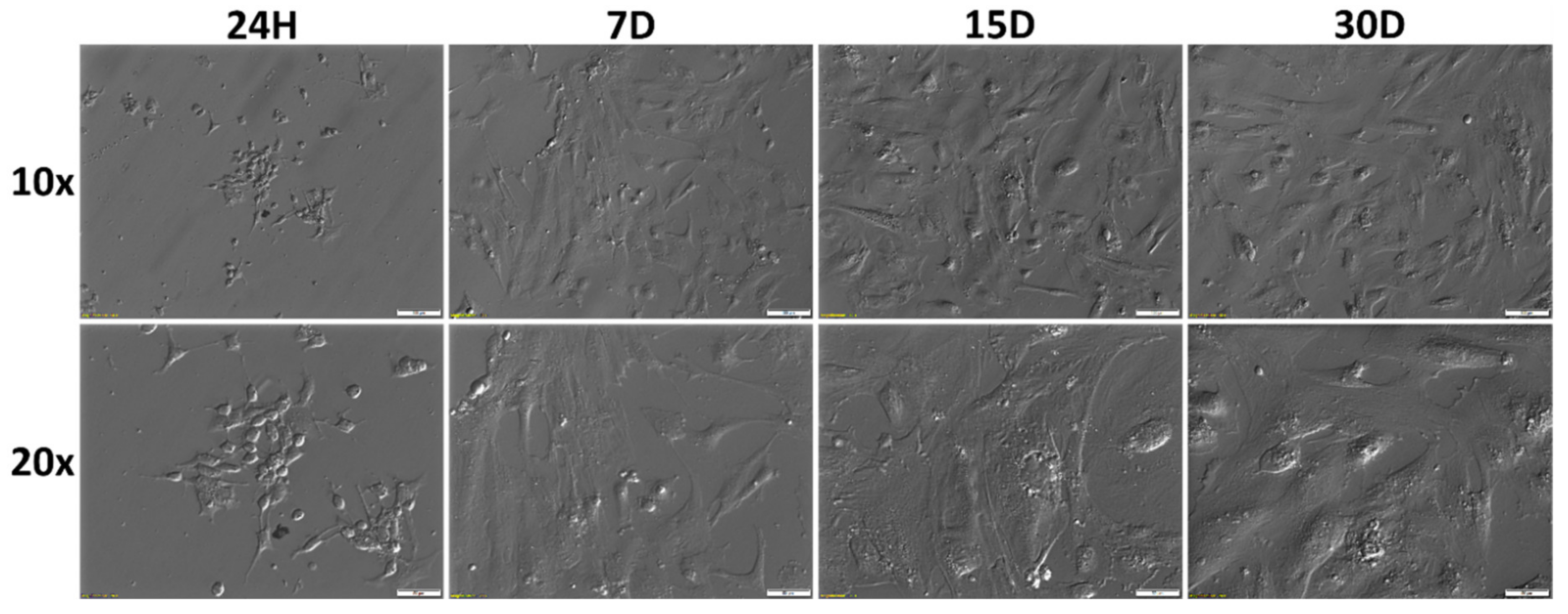
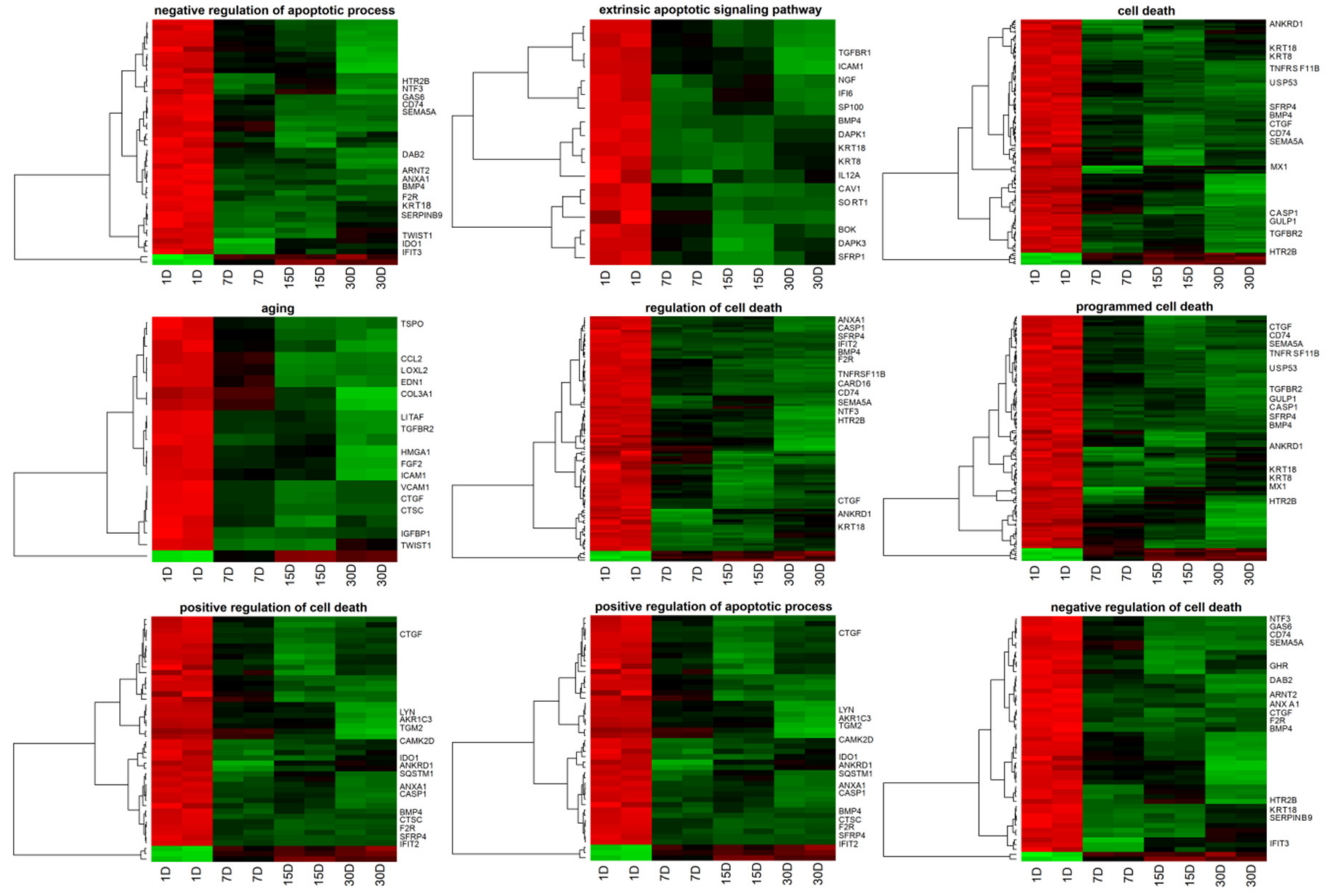
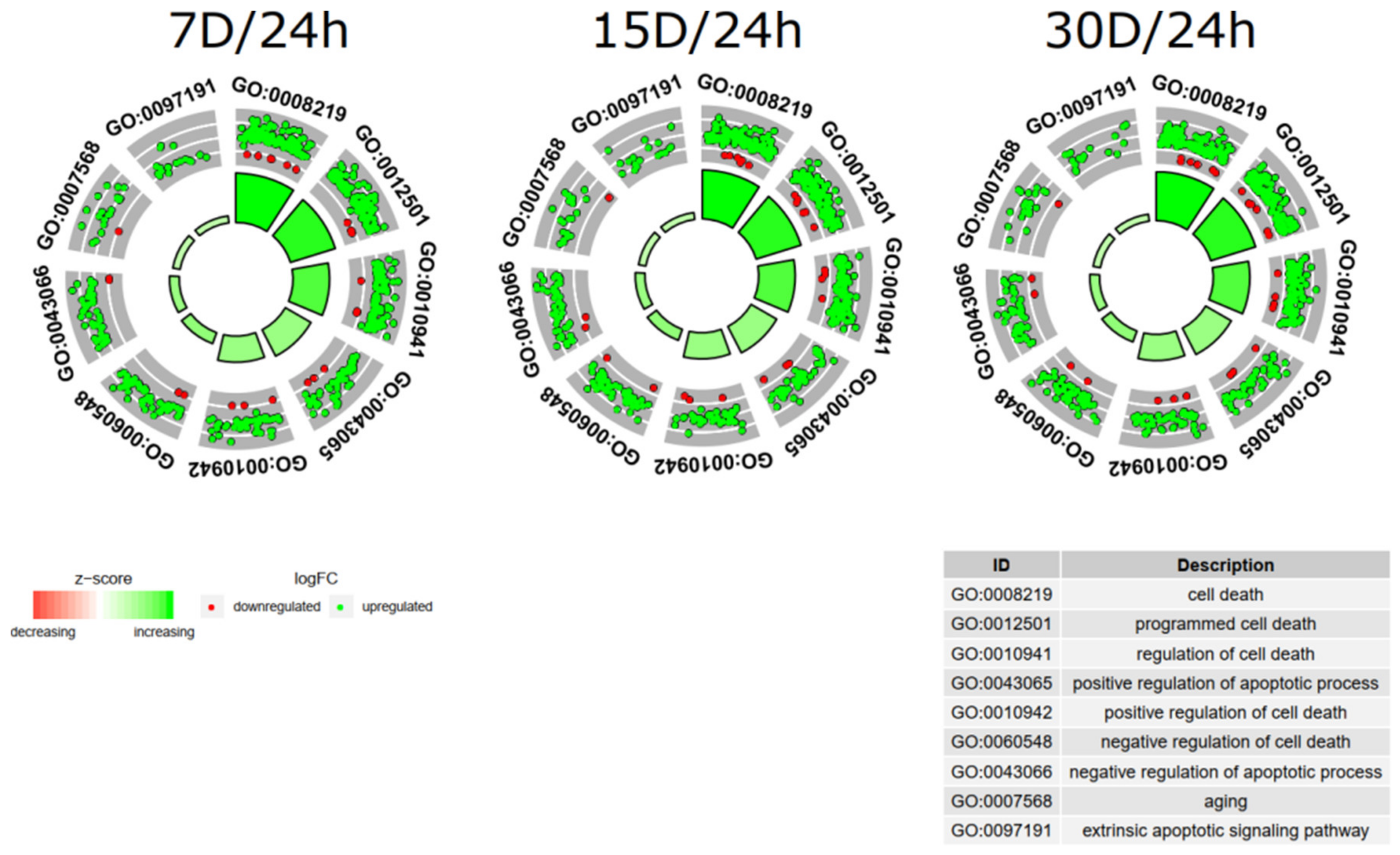

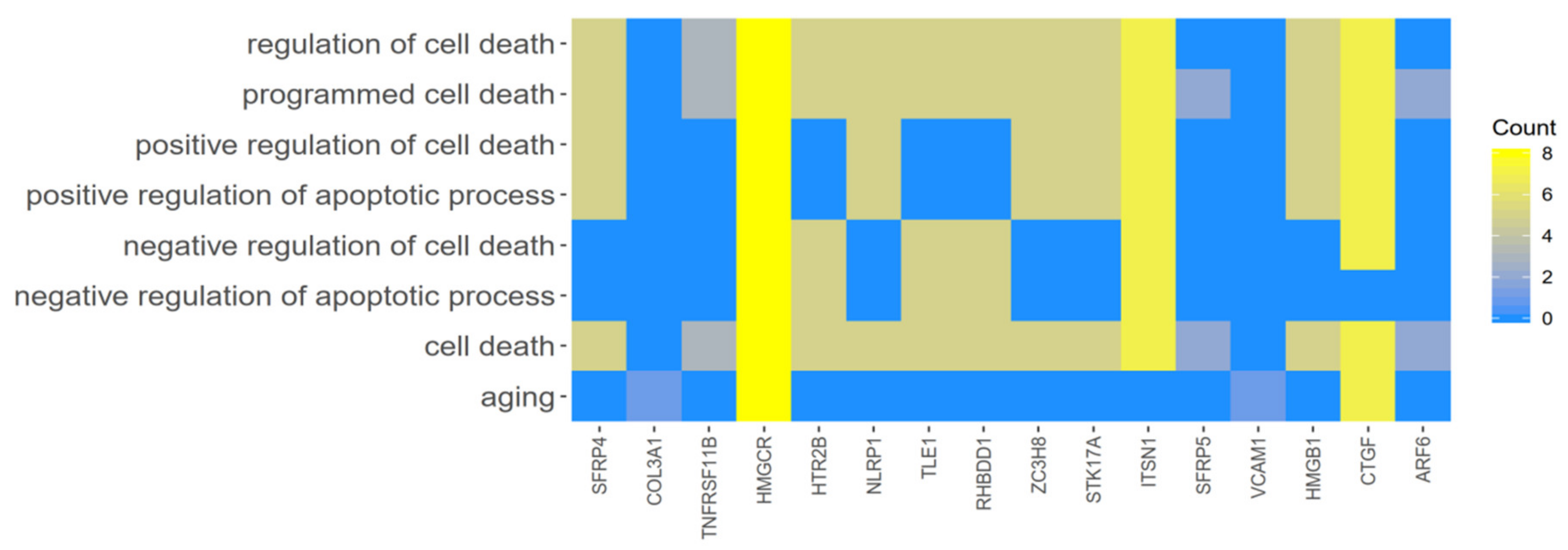
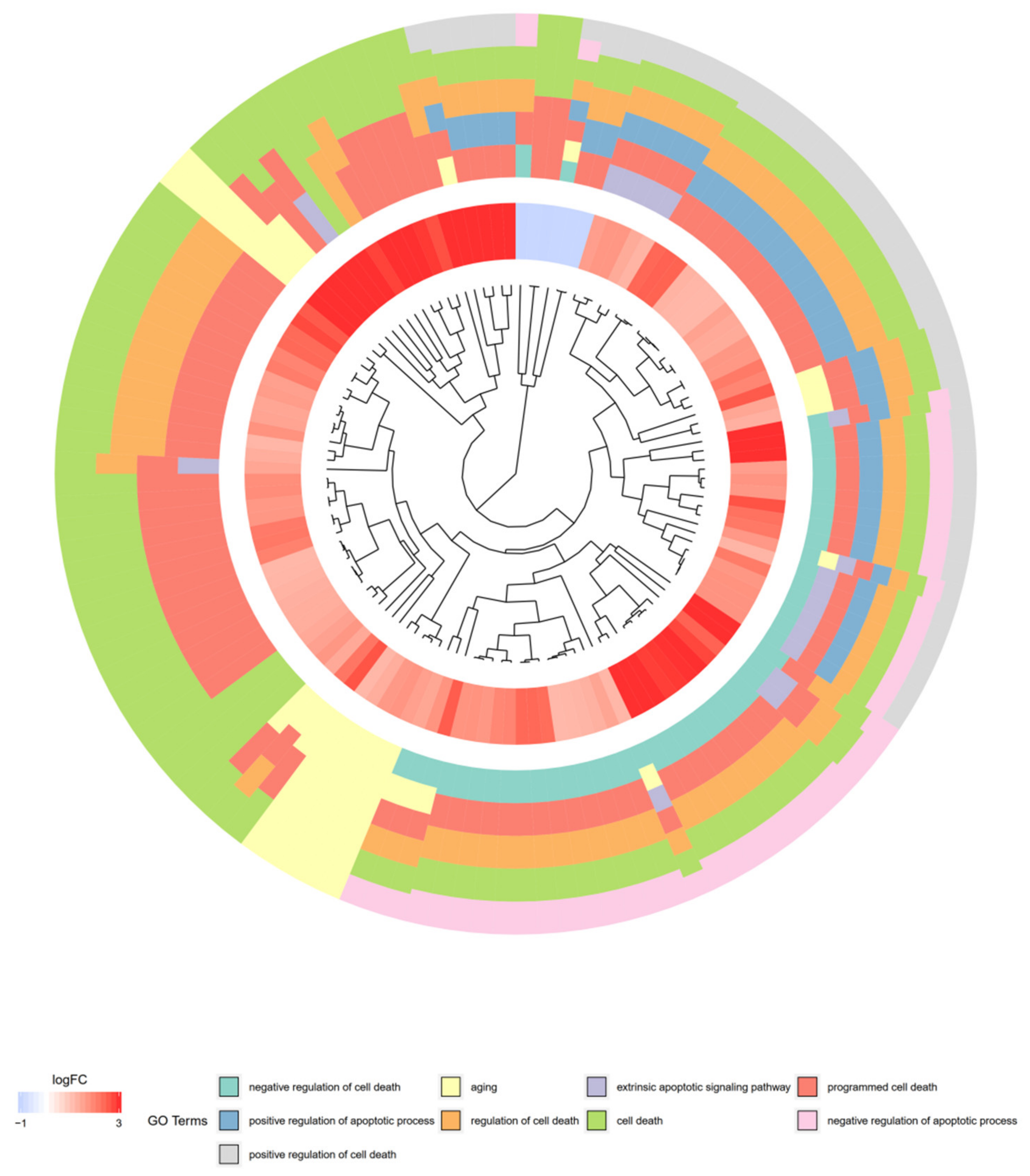
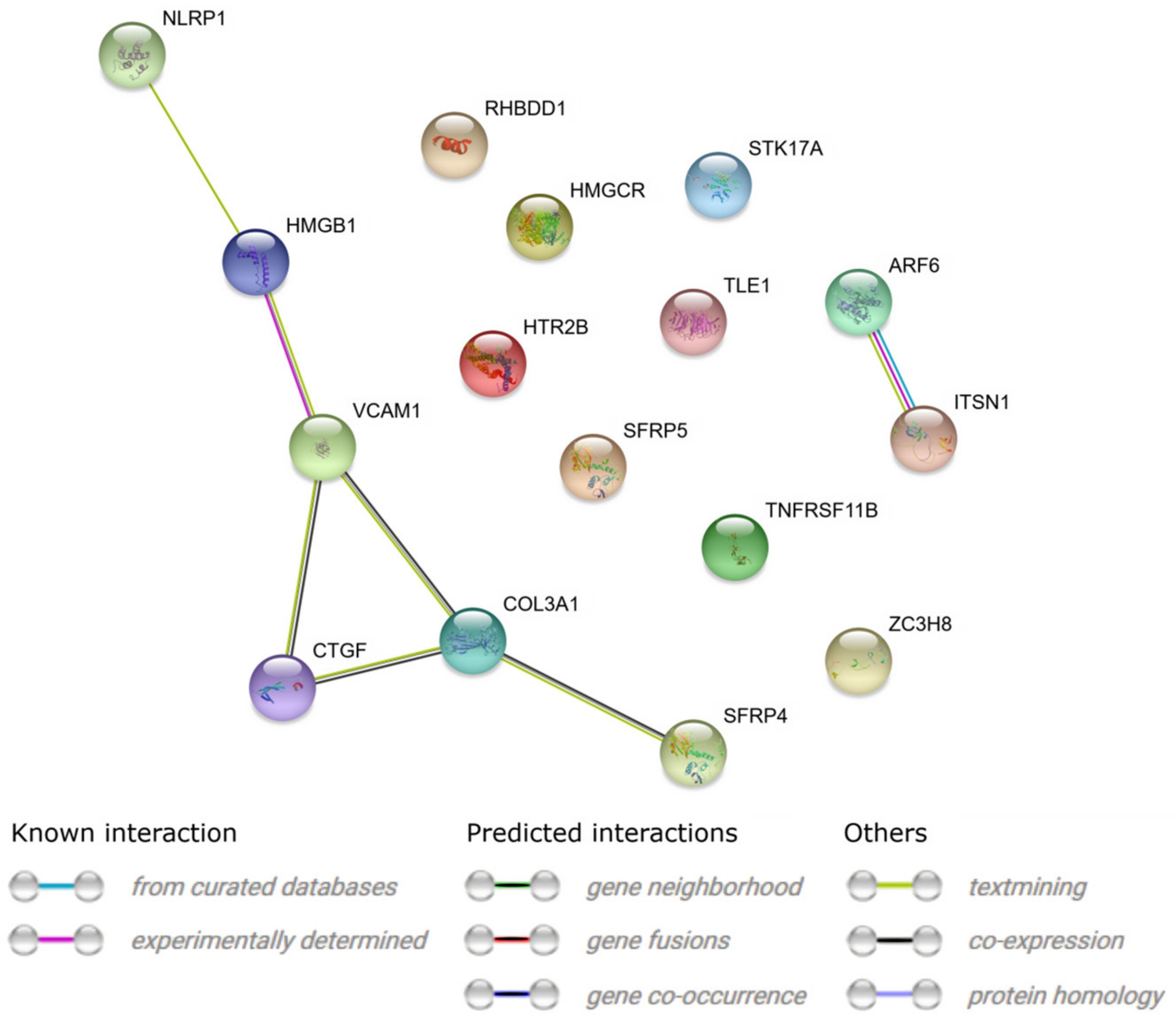

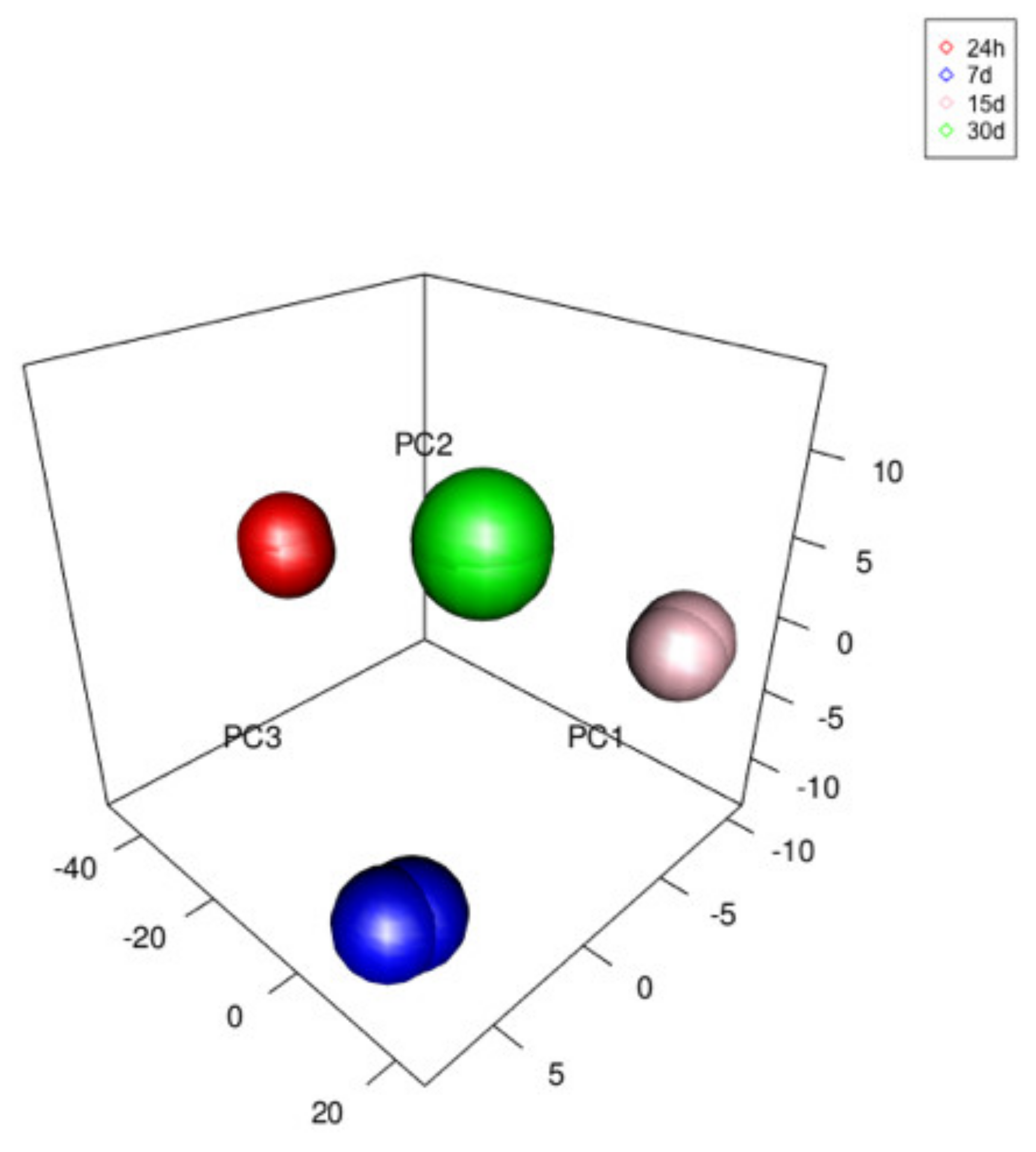

| Gene | Primer Sequences (5′-3′) | Product Size (bp) |
|---|---|---|
| COL3A1 | F: GGGAACAACTTGATGGTGCT R: CCTCCTTCAACAGCTTCCTG | 173 |
| SFRP4 | F: GCCTGGGACAGCCTATGTAA R: TCTGTACCAAAGGGCAAACC | 160 |
| HTR2B | F: GCCTTCTTCACACCTCTTGC R: TGTCCTTTCGAGAACCATCC | 199 |
| VCAM1 | F: CAGACAGGAAGTCCCTGGAA R: TTCTTGCAGCTTTGTGGATG | 212 |
| TNFRSF11B | F: GGCAACACAGCTCACAAGAA R: CTGGGTTTGCATGCCTTTAT | 241 |
| TLE1 | F: CGACAAGTCCATCAGCAGAA R: CCCAGATCACCCAGAAAGAA | 150 |
| STK17A | F: TGAATCTCCATTGGGTGACA R: CCACATATCTGTTGCCATGC | 154 |
| ITSN1 | F: CTCAGGAAAGGGACAAGCAG R: CTGGCTTAGCTGGTTCTTGG | 198 |
| NLRP1 | F: ATACTTCCCGAGGCATCCTT R: TTGCTTGCCTTTCATCTGTG | 160 |
| RHBDD1 | F: AGCTCCTGCCTTAGTGTGGA R: AGCAAATTGCAAGAGCAGGT | 225 |
| ARF6 | F: GGAAAAGGTGGAGTGGGTTT R: GCACCAACAGGAGCCTACAT | 245 |
| ZC3H8 | F: CATGCTCCACTGACTCCTGA R: CATCACCCCAGTCACACAAG | 215 |
| HMGB1 | F: ATATGGCAAAAGCGGACAAG R: GCAACATCACCAATGGACAG | 193 |
| HMGCR | F: GTCATTCCAGCCAAGGTTGT R: GGGACCACTTGCTTCCATTA | 228 |
| SFRP5 | F: TGGAGCCCAGAAAAAGAAGA R: GCAGGGGTAGGAGAACATGA | 247 |
| CTGF | F: GGAAAAGATTCCCACCCAAT R: TGCTCCTAAAGCCACACCTT | 153 |
| GAPDH | F: TCAGCCGCATCTTCTTTTGC R: ACGACCAAATCCGTTGACTC | 90 |
| ACTB | F: AAAGACCTGTACGCCAACAC R: CTCAGGAGGAGCAATGATCTTG | 132 |
| HPRT | F: TGGCGTCGTGATTAGTGATG F: ACATCTCGAGCAAGACGTTC | 141 |
| Gene Symbol | Entrez Gene ID | Ratio 7 d/24 h | Ratio 15 d/24 h | Ratio 30 d/24 h | Adj. p-val. 7 d/24 h | Adj. p-val. 15 d/24 h | Adj. p-val. 30 d/24 h | Mean Ratio |
|---|---|---|---|---|---|---|---|---|
| SFRP5 | 6425 | −2.0637 | −3.24762 | −3.37478 | 0.000111 | 3.10∙10−6 | 2.01∙10−6 | −2.89537 |
| HMGCR | 3156 | −2.03271 | −3.09191 | −2.68085 | 7.50∙10−6 | 2.38∙10−7 | 4.42∙10−7 | −2.60182 |
| HMGB1 | 3146 | −2.0542 | −2.26113 | −2.52655 | 6.96∙10−6 | 2.04∙10−6 | 6.84∙10−7 | −2.28063 |
| ZC3H8 | 84524 | −2.02274 | −2.09189 | −2.54816 | 0.00022 | 0.000114 | 2.06∙10−5 | −2.22093 |
| ARF6 | 382 | −2.04476 | −2.3896 | −2.1636 | 1.93∙10−5 | 3.58∙10−6 | 6.57∙10−6 | −2.19932 |
| RHBDD1 | 84236 | −2.06542 | −2.02064 | −2.20872 | 9.65∙10−5 | 8.14∙10−5 | 3.17∙10−5 | −2.09826 |
| NLRP1 | 22861 | 1.187027 | 1.450696 | 3.220824 | 0.164284 | 0.00633 | 4.21∙10−6 | 1.952849 |
| ITSN1 | 6453 | 3.052942 | 1.989949 | 2.094111 | 6.63∙10−5 | 0.000968 | 0.000558 | 2.379001 |
| STK17A | 9263 | 2.316524 | 2.118637 | 2.740376 | 8.16∙10−6 | 1.15∙10−5 | 1.29∙10−6 | 2.391846 |
| TLE1 | 7088 | 2.291749 | 2.358883 | 2.555574 | 3.64∙10−6 | 1.98∙10−6 | 8.50∙10−7 | 2.402069 |
| COL3A1 | 1281 | 2.994386 | 11.33677 | 56.74367 | 1.93∙10−6 | 9.27∙10−9 | 7.86∙10−10 | 23.69161 |
| SFRP4 | 6424 | 22.1843 | 28.77543 | 27.23046 | 5.34∙10−8 | 1.93∙10−8 | 1.44∙10−8 | 26.06339 |
| CTGF | 1490 | 18.97488 | 37.72449 | 24.63015 | 3.75∙10−9 | 6.96∙10−10 | 7.86∙10−10 | 27.10984 |
| HTR2B | 3357 | 24.3271 | 5.361072 | 52.86955 | 4.41∙10−8 | 1.50∙10−6 | 4.69∙10−9 | 27.51924 |
| VCAM1 | 7412 | 26.68641 | 58.39253 | 38.13633 | 3.75∙10−9 | 6.96∙10−10 | 7.86∙10−10 | 41.07175 |
| TNFRSF11B | 4982 | 28.13419 | 57.62667 | 105.3113 | 3.53∙10−8 | 6.38∙10−9 | 2.12∙10−9 | 63.69073 |
© 2020 by the authors. Licensee MDPI, Basel, Switzerland. This article is an open access article distributed under the terms and conditions of the Creative Commons Attribution (CC BY) license (http://creativecommons.org/licenses/by/4.0/).
Share and Cite
Chermuła, B.; Kranc, W.; Jopek, K.; Budna-Tukan, J.; Hutchings, G.; Dompe, C.; Moncrieff, L.; Janowicz, K.; Józkowiak, M.; Jeseta, M.; et al. Human Cumulus Cells in Long-Term In Vitro Culture Reflect Differential Expression Profile of Genes Responsible for Planned Cell Death and Aging—A Study of New Molecular Markers. Cells 2020, 9, 1265. https://doi.org/10.3390/cells9051265
Chermuła B, Kranc W, Jopek K, Budna-Tukan J, Hutchings G, Dompe C, Moncrieff L, Janowicz K, Józkowiak M, Jeseta M, et al. Human Cumulus Cells in Long-Term In Vitro Culture Reflect Differential Expression Profile of Genes Responsible for Planned Cell Death and Aging—A Study of New Molecular Markers. Cells. 2020; 9(5):1265. https://doi.org/10.3390/cells9051265
Chicago/Turabian StyleChermuła, Błażej, Wiesława Kranc, Karol Jopek, Joanna Budna-Tukan, Greg Hutchings, Claudia Dompe, Lisa Moncrieff, Krzysztof Janowicz, Małgorzata Józkowiak, Michal Jeseta, and et al. 2020. "Human Cumulus Cells in Long-Term In Vitro Culture Reflect Differential Expression Profile of Genes Responsible for Planned Cell Death and Aging—A Study of New Molecular Markers" Cells 9, no. 5: 1265. https://doi.org/10.3390/cells9051265
APA StyleChermuła, B., Kranc, W., Jopek, K., Budna-Tukan, J., Hutchings, G., Dompe, C., Moncrieff, L., Janowicz, K., Józkowiak, M., Jeseta, M., Petitte, J., Mozdziak, P., Pawelczyk, L., Spaczyński, R. Z., & Kempisty, B. (2020). Human Cumulus Cells in Long-Term In Vitro Culture Reflect Differential Expression Profile of Genes Responsible for Planned Cell Death and Aging—A Study of New Molecular Markers. Cells, 9(5), 1265. https://doi.org/10.3390/cells9051265







